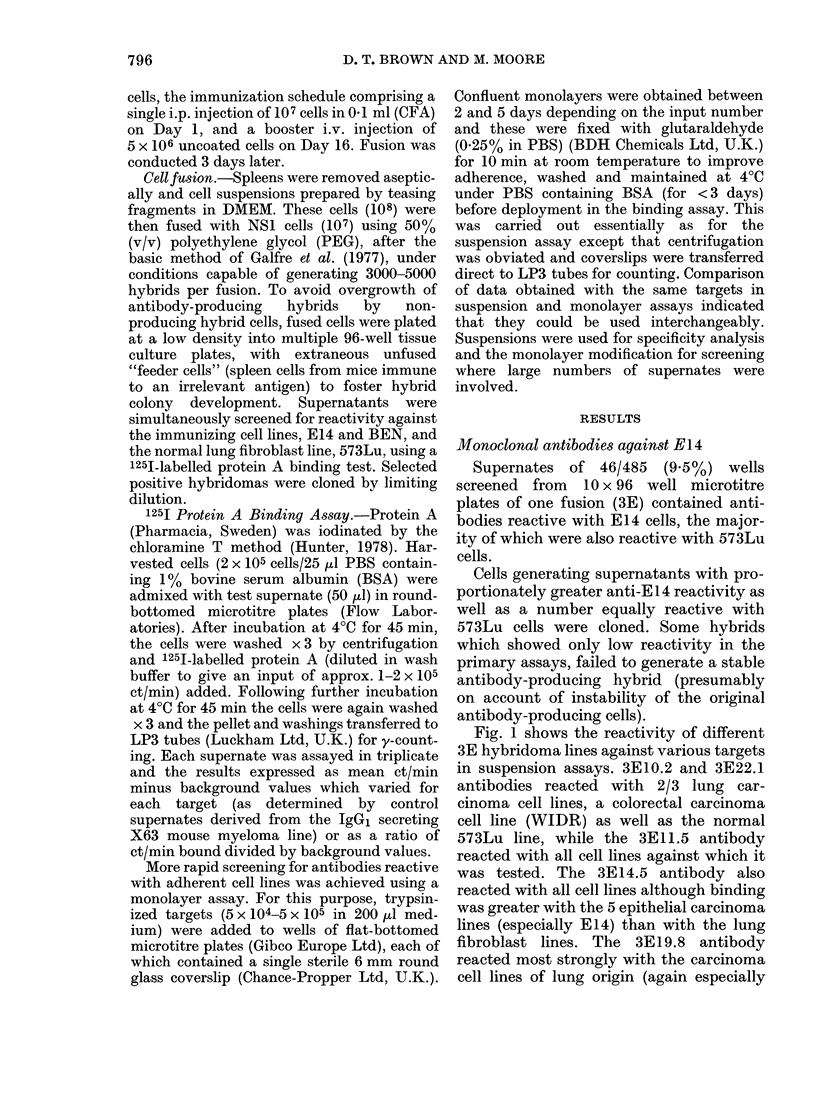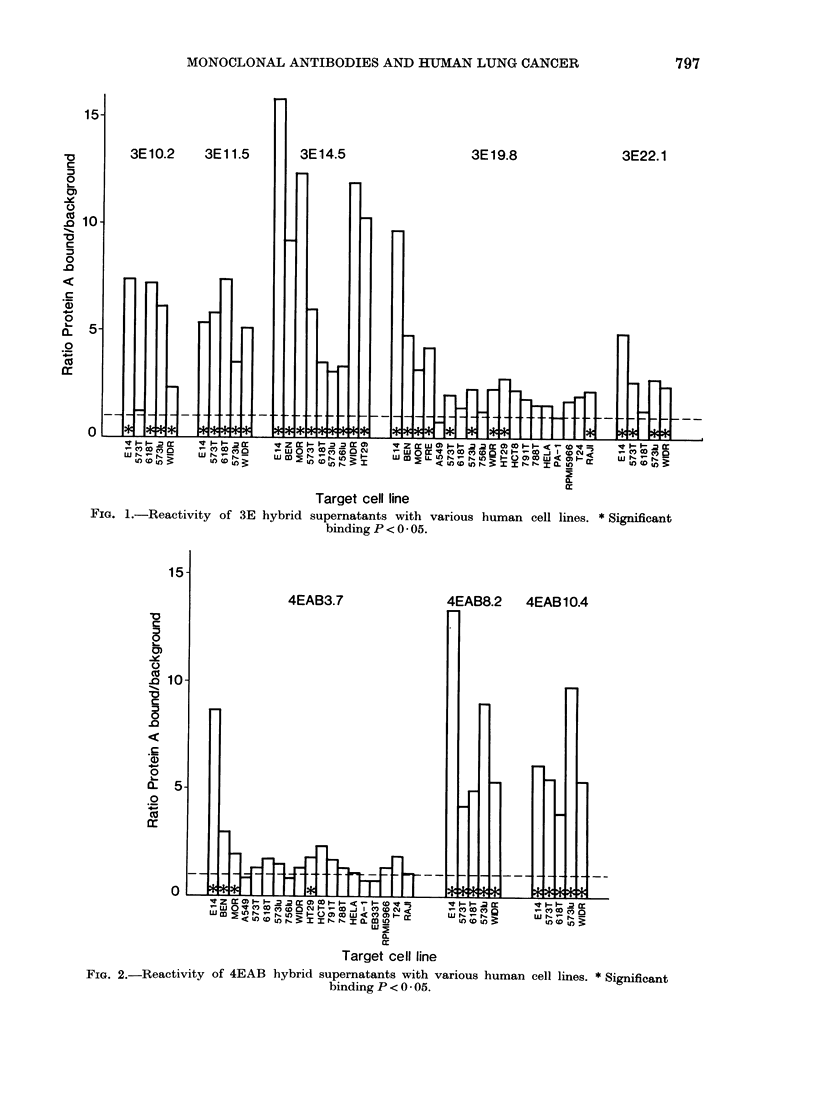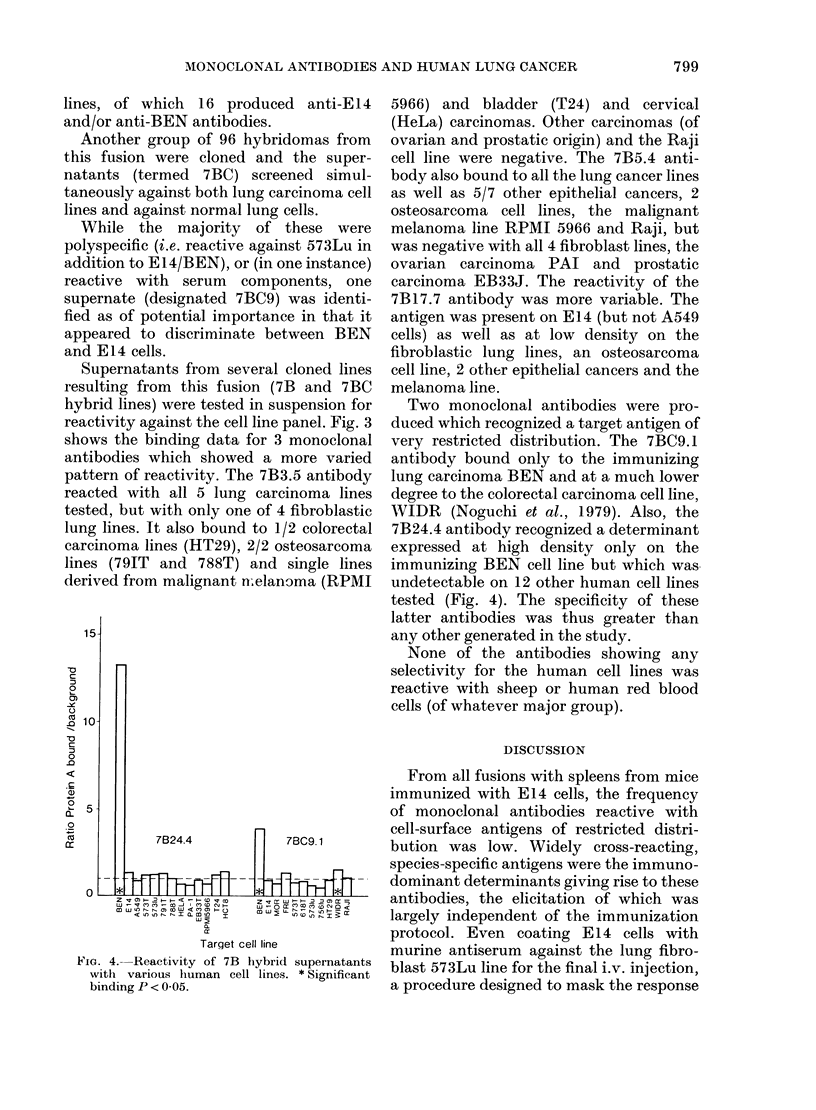Abstract
Monoclonal antibodies against 2 human lung carcinoma cell lines (E14 and BEN) were prepared by production and cloning of somatic cell hybrids between the murine myeloma NS1, and spleens from E14- and BEN-immune BALB/c mice. Approximately 2000 hybrid culture supernatants were screened for antibody simultaneously against the immunizing cell line and lung fibroblasts (573 Lu) using a radiolabelled Protein A binding assay. Although the vast majority secreted antibodies which recognized species-specific antigens, a few supernatants showed marked differential reactivity against E14 or BEN. These were cloned and subsequently tested against a panel of up to 25 human cell lines originating from different neoplastic and non-neoplastic tissues. Two anti-E14 clones (3E19.8 and 4EAB3.7) displayed preferential activity against lung cancer cell lines, but a low level of reactivity was also detectable with cell lines of different tissue provenance. The antibodies of 3 anti-BEN clones (7B3.5, 7B5.4, 7B17.7) likewise recognized antigens present to a higher density on lung cancer cell lines but were also reactive (to a variable extent for the different clones) with a diversity of other tumour cell lines. The antibodies of 2 further clones were exceptional in so far as one (7BC9.1) reacted only with BEN and WIDR (colorectal cancer) cells, while another (7B24.4) reacted, with apparent exclusivity, against BEN cells. With the exception of the latter, the distinction in antigen expression between many of the cell lines was quantitative rather than qualitative and the emergent picture is one of random expression of individual determinants on several disparate types of cancer cells, rather than restriction to cells of a given morphological type or histogenic derivation.
Full text
PDF







Selected References
These references are in PubMed. This may not be the complete list of references from this article.
- Boyle J. M., Hopkins J., Fox M., Allen T. D., Leach R. H. Interference in hybrid clone selection caused by Mycoplasma hyorhinis infection. Exp Cell Res. 1981 Mar;132(1):67–72. doi: 10.1016/0014-4827(81)90083-5. [DOI] [PubMed] [Google Scholar]
- Carrel S., Accolla R. S., Carmagnola A. L., Mach J. P. Common human melanoma-associated antigen(s) detected by monoclonal antibodies. Cancer Res. 1980 Jul;40(7):2523–2528. [PubMed] [Google Scholar]
- Cuttitta F., Rosen S., Gazdar A. F., Minna J. D. Monoclonal antibodies that demonstrate specificity for several types of human lung cancer. Proc Natl Acad Sci U S A. 1981 Jul;78(7):4591–4595. doi: 10.1073/pnas.78.7.4591. [DOI] [PMC free article] [PubMed] [Google Scholar]
- Embleton M. J., Gunn B., Byers V. S., Baldwin R. W. Antitumour reactions of monoclonal antibody against a human osteogenic-sarcoma cell line. Br J Cancer. 1981 May;43(5):582–587. doi: 10.1038/bjc.1981.87. [DOI] [PMC free article] [PubMed] [Google Scholar]
- Embleton M. J., Iype P. T. Surface antigens of rat liver epithelial cells grown in medium containing foetal bovine serum. Br J Cancer. 1978 Sep;38(3):456–460. doi: 10.1038/bjc.1978.229. [DOI] [PMC free article] [PubMed] [Google Scholar]
- Fischer P., Vetterlein M. Establishment and cytogenetic analysis of a cell line derived from a human epithelioma of the lung.. Oncology. 1977;34(5):205–208. doi: 10.1159/000225224. [DOI] [PubMed] [Google Scholar]
- Galfre G., Howe S. C., Milstein C., Butcher G. W., Howard J. C. Antibodies to major histocompatibility antigens produced by hybrid cell lines. Nature. 1977 Apr 7;266(5602):550–552. doi: 10.1038/266550a0. [DOI] [PubMed] [Google Scholar]
- Ham J., Ellison M. L., Lumsden J. Tumour calcitonin. Interaction with specific calcitonin receptors. Biochem J. 1980 Sep 15;190(3):545–550. doi: 10.1042/bj1900545. [DOI] [PMC free article] [PubMed] [Google Scholar]
- Irie R. F., Irie K., Morton D. L. Natural antibody in human serum to a neoantigen in human cultured cells grown in fetal bovine serum. J Natl Cancer Inst. 1974 Apr;52(4):1051–1058. doi: 10.1093/jnci/52.4.1051. [DOI] [PubMed] [Google Scholar]
- Kasai M., Saxton R. E., Holmes E. C., Burk M. W., Morton D. L. Membrane antigens detected on human lung carcinoma cells by hybridoma monoclonal antibody. J Surg Res. 1981 Apr;30(4):403–408. doi: 10.1016/0022-4804(81)90179-7. [DOI] [PubMed] [Google Scholar]
- Kennett R. H., Gilbert F. Hybrid myelomas producing antibodies against a human neuroblastoma antigen present on fetal brain. Science. 1979 Mar 16;203(4385):1120–1121. doi: 10.1126/science.424740. [DOI] [PubMed] [Google Scholar]
- Koprowski H., Steplewski Z., Herlyn D., Herlyn M. Study of antibodies against human melanoma produced by somatic cell hybrids. Proc Natl Acad Sci U S A. 1978 Jul;75(7):3405–3409. doi: 10.1073/pnas.75.7.3405. [DOI] [PMC free article] [PubMed] [Google Scholar]
- Köhler G., Milstein C. Continuous cultures of fused cells secreting antibody of predefined specificity. Nature. 1975 Aug 7;256(5517):495–497. doi: 10.1038/256495a0. [DOI] [PubMed] [Google Scholar]
- Liao S. K., Clarke B. J., Kwong P. C., Brickenden A., Gallic B. L., Dent P. B. Common neuroectodermal antigens on human melanoma, neuroblastoma, retinoblastoma, glioblastoma and fetal brain revealed by hybridoma antibodies raised against melanoma cells. Eur J Immunol. 1981 Jun;11(6):450–454. doi: 10.1002/eji.1830110603. [DOI] [PubMed] [Google Scholar]
- Lumsden J., Ham J., Ellison M. L. Purification and partial characterization of high-molecular-weight forms of ectopic calcitonin from a human bronchial carcinoma cell line. Biochem J. 1980 Oct 1;191(1):239–246. doi: 10.1042/bj1910239. [DOI] [PMC free article] [PubMed] [Google Scholar]
- Mazauric T., Mitchell K. F., Letchworth G. J., 3rd, Koprowski H., Steplewski Z. Monoclonal antibody-defined human lung cell surface protein antigens. Cancer Res. 1982 Jan;42(1):150–154. [PubMed] [Google Scholar]
- Noguchi P., Wallace R., Johnson J., Earley E. M., O'Brien S., Ferrone S., Pellegrino M. A., Milstien J., Needy C., Browne W. Characterization of the WIDR: a human colon carcinoma cell line. In Vitro. 1979 Jun;15(6):401–408. doi: 10.1007/BF02618407. [DOI] [PubMed] [Google Scholar]
- Shorthouse A. J., Smyth J. F., Steel G. G., Ellison M., Mills J., Peckham M. J. The human tumour xenograft--a valid model in experimental chemotherapy? Br J Surg. 1980 Oct;67(10):715–722. doi: 10.1002/bjs.1800671011. [DOI] [PubMed] [Google Scholar]
- Sikora K., Wright R. Human monoclonal antibodies to lung-cancer antigens. Br J Cancer. 1981 May;43(5):696–700. doi: 10.1038/bjc.1981.101. [DOI] [PMC free article] [PubMed] [Google Scholar]
- Yeh M. Y., Hellström I., Brown J. P., Warner G. A., Hansen J. A., Hellström K. E. Cell surface antigens of human melanoma identified by monoclonal antibody. Proc Natl Acad Sci U S A. 1979 Jun;76(6):2927–2931. doi: 10.1073/pnas.76.6.2927. [DOI] [PMC free article] [PubMed] [Google Scholar]


